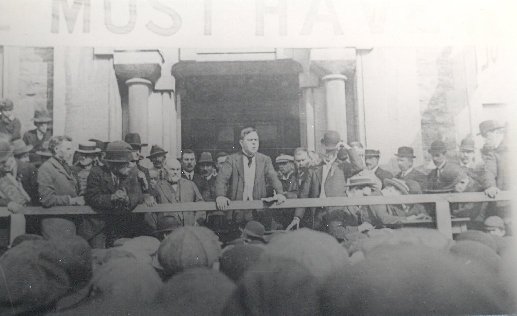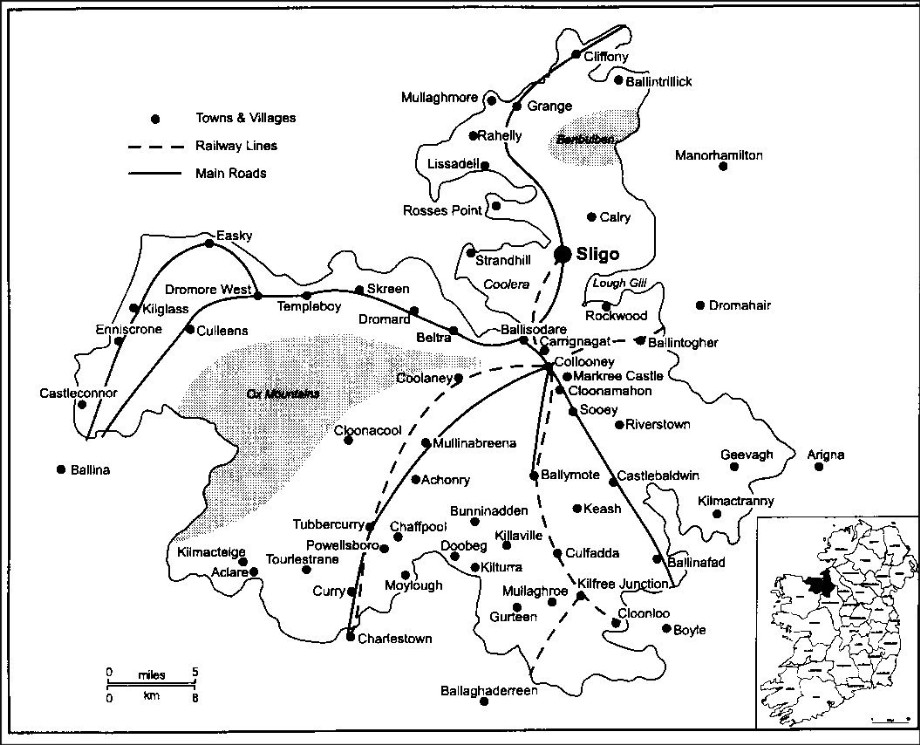Main menu:
Sligo Poets 1912-1923
County Sligo 1912
Sligo and 1912
County Sligo 1912
Sligo in 1911 it ranked twenty-second among Irish counties as regards land area and nineteenth in terms of population which then was 79,045.
The population of Sligo town had increased by 2.7% between 1901-1911 but the county was still overwhelmingly rural with just under 70% of those employed in the county engaged in agriculture. Farms were small; in 1901 almost 50% were fifteen acres or less, and only 3.5% were over 100 acres.
Railways linked Sligo to Dublin, Belfast, Limerick and Galway. Sligo port, the most important in the north-west, was linked to Liverpool, Glasgow and Derry and exported annually large numbers of cattle and agricultural produce from the surrounding districts.

The reforming Local Government Act of 1898 established Sligo County Council, Sligo Corporation and four Rural District Councils, Sligo, Tubbercurry, Dromore West and Boyle No. 2. The extension of the franchise meant that members elected were predominately nationalist.
Sligo Corporation’s finances were in an precarious state and workers’ housing as well as the streets and roads were in poor condition.
Left: North Sligo MP Thomas Scanlan speaking at a Home Rule meeting at Sligo Town Hall on Sunday 7 Sept. 1913. The banner reads: We must have Home Rule.
Non-Catholics made up 15% of the population of Sligo Borough, the highest of any Connacht town, and 10% of the county. Although the great landlords of County Sligo – Wood-Martins, Gore-Booths, Coopers and O’Haras – lost their political power as a result of the Local Government Act and sold much of their estates as a result of the Wyndham Land Act of 1903, Protestant businessmen continued to make significant contributions to the life of Sligo town.
These included Belfast-born Arthur Jackson who managed the Sligo Steam Navigation Company and served as chairman of Sligo Harbour Commissioners and Harper Campbell Perry who was a director of the Sligo Steam Navigation Company and a harbour commissioner.
The Protestants of Sligo were strong in their public opposition to the 1912 Home Rule Bill. Sligo branches of the Irish Unionist Alliance, the Junior Unionist Alliance and the Women's Unionist Alliance were formed in the county and held regular public meeting which got widespread coverage in the local newspapers. Major Bryan Cooper, a former MP for South Dublin, was to the fore in organising these groups.
In the first decade of the twentieth century nationalist Sligo was loyal to the re-united Irish Parliamentary Party (IPP) under the chairmanship of John Redmond. The United Irish League (UIL) operated as its constituency organization with branches in every parish in the county. Sligo was one of the best organized counties and at the end of March 1913 its UIL membership ranked fourth in Ireland.
Membership of the UIL was essential for anyone seeking office as it controlled all public bodies. Weekly columns of UIL branch reports in the local press detailed their concerns which were often agrarian and local, and included regular motions of confidence in the party and the leadership.
The UIL continued to agitate to force landlords to sell estates and give up grazing ranches. The Birrell Land Act (1909) granted the Congested Districts Board (CDB) compulsory purchase powers and increased its budget substantially leading to accelerated land purchase. It also extended the areas classified as ‘congested’ to include all County Sligo.
A Sligo Trades Council existed since the late 1890s and had campaigned for fair labour conditions and local industry. The UIL supported it from the beginning. In September 1911 a Sligo ITGWU branch was founded at a public meeting chaired by the Mayor, Daniel O’Donnell, and addressed by Walter Carpenter an ITGWU organizer. Dock worker and sailor, John Lynch, became the secretary of the branch which was soon one of the most active in the country.

Map of County Sligo
